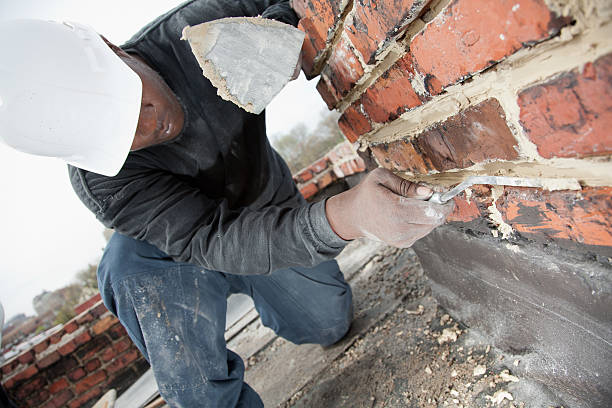Professional Siding Contractor Services to Boost Visual Charm
Professional Siding Contractor Services to Boost Visual Charm
Blog Article
Opening the Tricks of Sustainable Masonry Building Practices for Eco-Friendly Buildings
Amongst the myriad methods to green building, sustainable stonework construction stands out as a tried and true and sturdy technique that holds a wide range of untapped capacity. From the selection of products to innovative building and construction techniques, the tricks to achieving sustainability within masonry construction are multifaceted and interesting.
Benefits of Lasting Stonework Construction
Accepting lasting stonework building and construction methods not only reduces ecological effect but additionally uses long-term financial benefits to contractors and areas. By using materials like recycled blocks, blocks, and rocks, home builders can considerably lower the carbon footprint of their tasks while promoting source effectiveness. In addition, sustainable stonework building strategies, such as appropriate insulation and thermal mass buildings, can improve power effectiveness within structures, resulting in lowered operational prices over time.
Moreover, the durability and strength of masonry frameworks contribute to long-lasting economic benefits. Structures constructed utilizing lasting stonework practices commonly require less repair and maintenance, converting to cost financial savings for builders and property owners. The durability of stonework products also makes certain that structures remain steady and secure, minimizing the demand for frequent remodellings or substitutes.
Eco-Friendly Stonework Materials
Using environmentally friendly stonework products is a pivotal action towards boosting the sustainability of building and construction practices and decreasing environmental impact while maximizing lasting financial advantages. Sustainable stonework materials are sourced, generated, and used in a manner that lowers general ecological effect. Lasting concrete blocks include recycled aggregates and might feature better insulation homes, adding to energy performance in buildings.
Moreover, natural materials like adobe, rammed planet, and straw bales give exceptional thermal mass residential or commercial properties, lowering the need for heating and cooling down power. These materials are usually locally readily available, promoting local economies and decreasing transportation-related carbon exhausts. By selecting environment-friendly stonework materials, building and construction projects can considerably minimize their ecological impact and add to the production of healthier, more sustainable built environments.
Energy-Efficient Masonry Techniques
Power effectiveness plays an essential duty in improving the sustainability of masonry building and construction methods. One key energy-efficient stonework technique is the usage of thermal mass, which involves including dense products like concrete or brick right into the building's framework to soak up and keep warmth.

Developments in Sustainable Stonework
Current innovations in lasting masonry methods have produced cutting-edge strategies that are improving the building market. One such development is the growth of self-healing concrete, which uses germs embedded within the concrete to recover fractures autonomously. This advancement not just lowers maintenance costs yet likewise enhances the durability of stonework structures, adding to their sustainability.
One more noteworthy innovation is making use of recycled aggregates in stonework construction - masonry contractor. additional resources By including materials such as smashed ceramic waste or recycled glass into concrete blends, home builders can decrease the ecological effect of construction jobs while maintaining architectural integrity. This method not only draws away waste from landfills yet likewise preserves natural deposits, making it a vital improvement in sustainable masonry building
In addition, the assimilation of electronic design tools, such as Structure Information Modeling (BIM), is changing the way masonry frameworks are intended and constructed. BIM enables for even more precise computations, image source lowered material wastage, and enhanced power performance, ultimately resulting in even more lasting structure practices. These developments jointly indicate a promising future for sustainable masonry building in the age of eco-friendly buildings.
Future Trends in Masonry Sustainability
With the innovative strides made in sustainable masonry methods, the future patterns in stonework sustainability are positioned to more change the building and construction sector. Among the vital trends shaping the future of masonry sustainability is the enhanced combination of innovation. Improvements such as Structure Info Modeling (BIM) and online truth simulations are being utilized to optimize masonry building processes, leading to reduced product waste and boosted power effectiveness in buildings.
Additionally, the development of novel sustainable materials is established to play a substantial duty in improving the eco-friendliness of masonry construction. masonry contractor. Innovations like self-healing concrete, recycled aggregates, and bio-based binders are gaining grip for their capacity to decrease ecological impact while keeping architectural integrity

Conclusion
To conclude, lasting stonework building and construction techniques supply numerous benefits for environmentally friendly buildings. By using green products and energy-efficient techniques, masonry can contribute to a much more sustainable developed setting. Developments in sustainable masonry are continuously being developed to further boost the ecological performance of structures. Looking in the direction of the future, the pattern of masonry sustainability is anticipated to expand, bring about even more ecologically friendly and energy-efficient building practices in the years to come.
Report this page